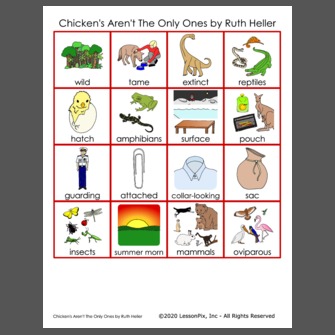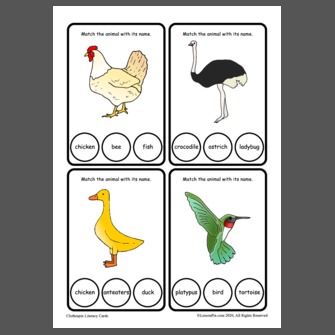
Chicken's Aren't The Only Ones - by Ruth Heller
(Support the author by purchasing this book here.)
This delightful book teaches about all the different animals who lay eggs, from chickens to rays, to the platypus. The author uses fun rhymes, interesting facts, and beautiful illustrations to engage the readers.
Often used within the education setting, this book complements science units on life sciences. It can promote skills in classification, sorting, same and different, attributes, and general knowledge. This book is written with simple rhyming prose, yet includes rich vocabulary for cross-curriculum instruction. Check out the book on YouTube here.
LessonPix provides tools to create custom learning materials to meet needs of diverse learners and instructional methods. The Sharing Center offers pre-made materials to download or customize to help you get started.
Here are some great activities to use with the book, "Chicken's Aren't The Only Ones" by Ruth Heller.
Before you Read
Make a list together of all the animals your can think of who lay eggs. (There may be many birds!)
Or do a K-W-L Chart on Eggs (Know, Want to know, and Learned, more info on KWL strategy here)
Vocabulary
Consider vocabulary before you reread the story. Here are some more challenging words from the story.
| wild | tame | extinct | reptiles |
| hatch | pouch | surface | amphibians |
| guarding | attached | sacs | collar-looking |
| insects | chrysalis | mammals | oviparous |
Here are two styles of vocabulary cards to match within the story or display on a word wall.
Practice oviparous animal vocabulary with this board game. (open in Powerpoint for telepractice)
Play Memory-Matching by printing and cutting out 2 sets of egg-shaped cards.
Comprehension
Here are some Comprehension Questions from the story. Stop and ask along the way or at the end of the story. (Open in powerpoint for distance learning and use circles as tokens to mark answers.)
Sort by Categories
Consider the categories of animals that lay eggs and discuss. (Are dinosaurs reptiles? Is a ray a fish? Is a spider an insect?)
Or sort the animals into the categories
Alphabet and Phonics
E is for Egg! Decorate an E with markers, feather, playdough, or other small crafts.
Sort the words that start with e. Do you hear a long or short E sound?
Talk about CH letter combination and how this combination makes a new sound. What words do you know that start with CH?
Writing Activities
Can you draw or list animas that lay eggs? Do before and after the story.
Write the names of these oviparous animals.
Predicatble Chart Writing. Or cut and paste these simple sentences in order and fill in the blank.
Imagine you found an egg. What would you do? How can you tell what's inside?
Science
Study the life cycle of a chicken.
Put birds and eggs in size order (adapted from Tali Kellerstien's the Odd Egg material in the sharing center).
Cooking: make a smiple chicken pot pie.
Expanded Activities based on story vocabulary or concepts
Make Puppets or lacing cards using animals from the story.
Place cards in a pile. Draw a card and put together plastic eggs to match the picture on the card.
Match the animal to it's word.
Cooperative Learning: Tape a toilet paper or paper towel roll to the back of the cut out chicken picture card. Students sit in a circle. One student holds the chicken and says a word that starts with an E (or designated letter or sound) and drops a plastic egg through the tube. The person next to them catches the egg and then repeats the process with their neighbor. You can play music or put on a timer to make it like a hot potato game. For younger kids, you may have some pictures of vocabulary available for reference.





























 Facebook
Facebook Twitter
Twitter Pinterest
Pinterest